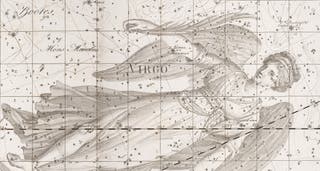Cellarius, Andreas. Harmonia macrocosmica. Amsterdam, 1661.
Many of the innovations in celestial cartography first appeared on star globes, rather than flat maps. The globes of Gerard Mercator (1551), Petrus Plancius (1598) and Willem Blaeu (1598 and 1616) were all very important in determining style, and introducing new constellations and methods of nomenclature. For example, it was the 1598 globe of Plancius that first utilized the new star positions of Tycho Brahe and introduced the new southern constellations, five years before Bayer incorporated both features into his Uranometria. However, these globes are so scarce (in the case of the Plancius 1598 globe, no longer extant at all), that it is difficult to assess their role in helping change the face of celestial maps in the seventeenth century.
Perhaps the best surrogate for viewing one of these grand globes is to look at the two large celestial planispheres that were published in Cellarius's sumptuous Harmonia macrocosmica. These maps capture some of the scale of the globes; if one of the planispheres were wrapped onto a sphere, it would produce a globe about 26 cm in diameter, or 2/3 the size of a typical Blaeu/Plancius globe. The style of Cellarius's maps seems to have been derived from the globes of Plancius and Blaeu. For example, Plancius had shown Cancer as a lobster, and Cellarius adopts the same convention; it is quite different from the Cancer of Bayer's Uranometria. In fact, Plancius had invented a new constellation, Cancer Minor, the little crab, and Cellarius included that also (see above), along with a number of other newly-coined Plancius constellations. Some of the northern constellation figures, such as Cepheus and Bootes, are dressed in warm winter clothing; this was another novelty first introduced on the early Blaeu globes.
The Christian Zodiac in Andreas Cellarius, Harmonia macrocosmica, 1661.
In addition to providing two classical planispheres, Cellarius also included two others, copied from Schiller's atlas, that show the new Christian constellations; the reader is, in a way, given a choice between tradition and piety. The choice was apparently made in behalf of tradition, for if we do not count later editions of Cellarius' work, this marks the swansong (or should we say the cock's crow) of the Schiller constellations.
On this slight detail of the second Christian planisphere, we can make out six of the zodiacal saints, including St. Andrew with his crude cross, as well as the Sepulcher at the top, and the Red Sea plunging down to the bottom. All of these figures were taken from Julius Schiller, Coelum stellatum Christianum, 1627.
The other Christian planisphere, which shows the other half of the globe, contains a marvelous version of Noah's ark, which bears up well even in enlargement. See a detail, and a comparison with the ark of Schiller. See further down full page depictions of two of the planispheres, which show little detail but give an idea of the grand scale.

